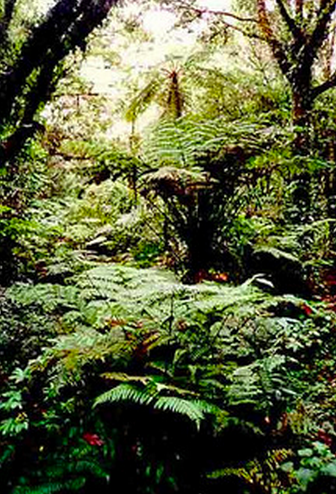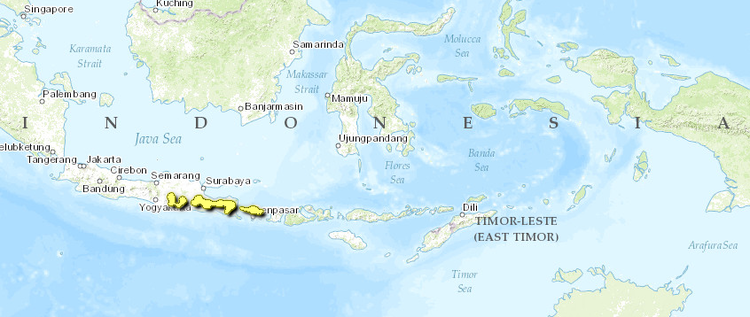Eastern Java-Bali montane rain forests
Introduction The Eastern Java-Bali Montane Rain Forests are found on one of the most actively volcanic (Eastern Java-Bali montane rain forests) islands in the world. Once the home of the extinct Javan and Balinese tigers (Panthera tigris sundaica and Panthera tigris balica, respectively), they contain fifteen bird species found nowhere else on Earth and more than 100 mammal species. Nearly three-quarters of the ecoregion's natural habitat has been cleared by a rapidly expanding population that is increasingly forced into these marginal lands.
Location and General Description
This ecoregion represents the montane forests of eastern Java and Bali, Indonesia. Based on the Köppen climate zone system, this ecoregion falls in the tropical wet and dry climate zones. Java probably did not exist before the Miocene (24 million years ago). Bali did not emerge until 3 million years ago. Truly born of fire, the islands of Java and Bali are the result of the subduction and remelting of the Australian-Indian Ocean tectonic plate beneath the Eurasian tectonic plate at the Java trench. The melted crust has risen as volcanoes and, along with subsequent sedimentation, created Java. Therefore, the surface geology consists of Tertiary and Quaternary volcanics, alluvial sediments, and areas of uplifted coral limestone. Twenty of the volcanoes on Java and Bali have been active in historic times, and they are among the most active volcanic islands in the world. During previous ice ages, when sea levels were much lower, Java and Bali were connected to Sumatra, Borneo, and the rest of the Asian mainland.
The predominant forest types found in the ecoregion include evergreen rain forest, moist deciduous forest, and seasonal and aseasonal montane forest. The forest type found at any particular location depends on a variety of factors including elevation, soils, aspect, and longitude; the ecoregion tends to become drier as one moves east. The transition between the evergreen rain forest and moist deciduous forest, which is typical of the lowlands, and montane forest generally is gradual in Java and Bali.
Evergreen rain forests of Java contain Artocarpus elasticus (Moraceae), Dysoxylum caulostachyum (Meliaceae), langsat Lansium domesticum (Meliaceae), and Planchonia valida (Lecythidaceae). Moist deciduous forests are drier than the evergreen rain forests and have 1,500-4,000 millimeters of rainfall annually, with a four- to six-month dry season. Common lowland deciduous trees in eastern Java and Bali are Homalium tomentosum, Albizia lebbekoides, Acacia leucophloea, A. tomentosa, Bauhinia malabarica, Cassia fistula, Dillenia pentagyna, Tetrameles nudiflora, Ailanthus integrifolia, and Phyllanthus emblica. Many herbaceous plants are confined to the deciduous forests.
The transition between lowland and montane forests is a floristic one, and some plant families and genera are found only on one or the other side of this transition. Above 1,000 meters, genera begin to include Anemone, Aster, Berberis, Galium, Gaultheria, Lonicera, Primula, Ranunculus, Rhododendron, Veronica, and Viola. Some lowland tree species transition out up to 1,200 meters (m). The most abundant montane tree species in the lower montane zone are Lithocarpus, Quercus, Castanopsis, Fagaceae, and laurels (Lauraceae). Magnoliaceae, Hammamelidaceae, and Podocarpaceae are also well represented. Few emergents, primarily Atingia excelsa and Podocarpus spp., are found in the lower montane zone, but tree ferns are common.
In the gradual transition from lower to upper montane forest, which begins at approximately 1,800 m, enormous quantities of Aerobryum moss begin to become prevalent on all surfaces. Dacrycarpus (Podocarpus) continues up from the lower montane. Ericaceae shrubs are very characteristic of the upper montane zone, including Rhododendron, Vaccinium, and Gaultheria. Sub-alpine forest, found above 3,000 m, contains one species-poor layer of trees, including Rhododendron and Vaccinium. Edelweiss (Anaphalis javanica) is characteristic of the sub-alpine zone.
Biodiversity Features
Overall richness and endemism in this ecoregion are low to moderate compared with those of other ecoregions. The ecoregion provides habitat for approximately 100 mammal species, including one-Megaerops kusnotoi-that is an ecoregional near-endemic species (Table 1). Among the mammals of conservation significance are the wild dog (Cuon alpinus) and endangered Javan leopard (Panthera pardus melas). The Javan tiger (Panthera tigris) once inhabited this ecoregion but is now extinct.
|
Table 1. Endemic and Near-Endemic Mammal Species. Family Species Pteropodidae Megaerops kusnotoi The bird fauna exceeds 215 species and includes 18 endemics and near endemics (Table 2). The ecoregion overlaps with the eastern portion of the Java and Bali forests EBA. Thirty-four bird restricted-range bird species are found in the EBA, of which thirty are found in the montane habitats (Eastern Java-Bali montane rain forests) of this ecoregion. Two bird species in the ecoregion are considered threatened: the Javan hawk-eagle (Spizaetus bartelsi) (endangered) and the Javan scops-owl (Otus angelinae) (vulnerable). {| width="620" border="1" cellpadding="1" align="center" ! colspan="3" align="center" | Table 2. Endemic and Near-Endemic Bird Species. Family Common Name Species Accipitridae Javan hawk-eagle Spizaetus bartelsi Columbidae Pink-headed fruit-dove Ptilinopus porphyreus Columbidae Dark-backed imperial-pigeon Ducula lacernulata Strigidae Javan owlet Glaucidium castanopterum Caprimulgidae Salvadori's nightjar Caprimulgus pulchellus Capitonidae Flame-fronted barbet Megalaima armillaris Rhipiduridae Rufous-tailed fantail Rhipidura phoenicura Rhipiduridae White-bellied fantail Rhipidura euryura Campephagidae Sunda minivet Pericrocotus miniatus Pycnonotidae Sunda bulbul Hypsipetes virescens Zosteropidae Javan grey-throated white-eye Lophozosterops javanicus Sylviidae Sunda warbler Seicercus grammiceps Timaliidae Rufous-fronted laughingthrush Garrulax rufifrons Timaliidae White-bibbed babbler Stachyris thoracica Timaliidae Crescent-chested babbler Stachyris melanothorax Timaliidae Grey-cheeked tit-babbler Macronous flavicollis Nectariniidae White-flanked sunbird Aethopyga eximia Fringillidae Mountain serin Serinus estherae (Eastern Java-Bali montane rain forests) ==Current Status== Nearly three-quarters of the ecoregion's natural habitat has been cleared by a rapidly expanding population. The remaining forest is scattered throughout the landscape as small patches, mainly limited to the steep slopes of the volcanoes. There are twelve protected areas that cover 3,690 km2 (23 percent) of the ecoregion (Table 3). At 307 square kilometers (km2), the average size of the protected areas in the ecoregion is large, with Gunung Raung being the largest. This mountain range has more active volcanoes than are found anywhere else in the world. The vegetation of this ecoregion has been disturbed by repeated volcanic activity. Fires are common, and Casuarina junghuhniana, a secondary forest species, occurs gregariously in burned areas. {| width="620" border="1" cellpadding="1" align="center" ! colspan="3" align="center" | Table 3. WCMC (1997) Protected Areas That Overlap with the Ecoregion. Protected Area Area (km2) IUCN Category Gunung Picis 20 I Bromo Tengger Semeru 610 II Gunung Lawu 290 ? Arjuno Lalijiwo 60 ? Gunung Liman Wilis 230 ? Gunung Kawi/Kelud 410 ? Sungai Kolbu Lyang Pintean 180 ? Bali Barat 470 II Meru Betiri 180 II Gunung Raung 1,040 ? Batukau I/II/III NR 160 I Gunung Abang GR 40 ? Total 3,690 (Eastern Java-Bali montane rain forests) ==Types and Severity of Threats== Java also has one of the highest human population densities in Asia, and these [[population]s] are being continually forced into steep, upper watersheds and more marginal environments, where they have had significant destructive effects on nutrient outflow, total water yield, peak storm flows, and stream sedimentation. Visitors to the mountains often collect plants, and over the years this collection has taken a toll on many of the plant populations. ==Justification of Ecoregion Delineation== MacKinnon (1997) included the islands of Java and Bali in biounit 22 (with three subunits). Western Java is wetter than the eastern half of the island, and the forests are richer in species. There are also floristic differences between the lowland and montane vegetation in Java and Bali. Therefore, using MacKinnon's subunit boundary, we delineated the Western Java Rain Forests to represent the moister evergreen forests to the west and the Eastern Java-Bali Rain Forests to represent the drier, less species-rich forests of eastern Java and Bali. However, we also extracted the montane forests into distinct ecoregions-Western Java Montane Rain Forests and Borneo Montane Rain Forests-using the 1,000 m elevation contour of a DEM. ==Additional Information on this Ecoregion== * For a shorter summary of this entry, see the WWF WildWorld profile of this ecoregion. * To see the species that live in this ecoregion, including images and threat levels, see the WWF Wildfinder description of this ecoregion. * World Wildlife Fund Homepage |
|---|

